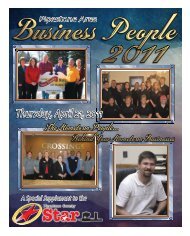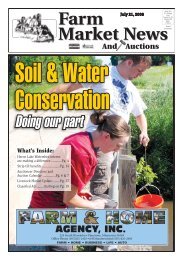to download the Pipestone National Monument 75th Edition.
to download the Pipestone National Monument 75th Edition.
to download the Pipestone National Monument 75th Edition.
Create successful ePaper yourself
Turn your PDF publications into a flip-book with our unique Google optimized e-Paper software.
12 – PIPESTONE COUNTY STAR THURSDAY, AUGUST 16, 2012The evolution of Pipes<strong>to</strong>ne <strong>National</strong> <strong>Monument</strong>Geologists believeclay was depositedat <strong>the</strong> bot<strong>to</strong>m ofa sea where overmillions of yearsheat, pressure andchemical reactionstransformed it in<strong>to</strong>pipes<strong>to</strong>ne.The datearcheologistsplace on <strong>the</strong>earliestpipes<strong>to</strong>neartifacts.Archeologicalevidence showsthat quarryingintensified duringthis time period.French fur tradersreport visits <strong>to</strong> <strong>the</strong>“village of <strong>the</strong> reds<strong>to</strong>nequarry.” It is<strong>the</strong> first report of awhite personvisiting <strong>the</strong>quarries.Explorer Philander HenryPrescott records <strong>the</strong>first written account ofa white person visiting<strong>the</strong> quarries. O<strong>the</strong>r whiteexplorers includingGeorge Catlin (1836) andJoseph Nicollet and JohnCharles Fremont (1838)visit quarries.WadsworthLongfellowpublishes “TheSong ofHiawatha,”which references“<strong>the</strong> great RedPipe-s<strong>to</strong>neQuarry.”Pipes<strong>to</strong>ne<strong>National</strong><strong>Monument</strong>created on115 acres ofland.Circle trail developed(1950). Additionalacres, including <strong>the</strong>Three Maidens area,are transferred <strong>to</strong> <strong>the</strong><strong>Monument</strong>, bringing<strong>to</strong>tal park land <strong>to</strong> 282acres by 1957. TheVisi<strong>to</strong>rs Center opensin 1958.Today, <strong>the</strong> <strong>Monument</strong>has 301 acres; ninefulltime employees;and 23 affiliated tribes.1 billion years ago1000 B.C.700-1200 A.D. 1700 1830s 1855 1937 1950s2012 - <strong>75th</strong>AnniversarySacred originsContinued from page 7this, she <strong>to</strong>ok from <strong>the</strong> bundle a pipe, andalso a small round s<strong>to</strong>ne which she placedupon <strong>the</strong> ground. Holding <strong>the</strong> pipe up withits stem <strong>to</strong> <strong>the</strong> heavens, she said: ‘With thissacred pipe you will walk upon <strong>the</strong> Earth; for<strong>the</strong> Earth is your Grandmo<strong>the</strong>r and Mo<strong>the</strong>r,and She is sacred. Every step that is takenupon her should be as a prayer. The bowlof this pipe is of red s<strong>to</strong>ne; it is <strong>the</strong> Earth.Carved in <strong>the</strong> s<strong>to</strong>ne and facing <strong>the</strong> center isthis buffalo calf who represents all <strong>the</strong> fourleggedswho live upon your Mo<strong>the</strong>r. The stemof <strong>the</strong> pipes is wood, and this represents allthat grows upon <strong>the</strong> Earth. And <strong>the</strong>se twelvefea<strong>the</strong>rs which hang here where <strong>the</strong> stem fitsin<strong>to</strong> <strong>the</strong> bowl are from <strong>the</strong> Wanbli Galeshka,<strong>the</strong> Spotted Eagle, and <strong>the</strong>y represent <strong>the</strong>eagle and all <strong>the</strong> wingeds of <strong>the</strong> air. All <strong>the</strong>sepeoples, and all <strong>the</strong> things of <strong>the</strong> universe,are joined <strong>to</strong> you who smoke <strong>the</strong> pipe — allsend <strong>the</strong>ir voices <strong>to</strong> Wakan-Tanka, <strong>the</strong> GreatSpirit. When you pray with this pipe, youpray for and with everything’.”-Black Elk, LakotaThese are a few of <strong>the</strong> many s<strong>to</strong>ries thathave been passed down over <strong>the</strong> years about<strong>the</strong> sacred origins of <strong>the</strong> pipes<strong>to</strong>ne quarriesand <strong>the</strong> pipes made from <strong>the</strong> s<strong>to</strong>ne.Archeological surveys have revealedthat beginning around 1,000 B.C., artifactsmade of pipes<strong>to</strong>ne from <strong>the</strong> area around1106 8th Street S.W., Pipes<strong>to</strong>ne, MN 56164(507) 825-4201 Open 6am-MidnightPipes<strong>to</strong>ne <strong>National</strong> <strong>Monument</strong> were tradedas far east as modern Ohio, as far south as<strong>the</strong> Kansas River, and as far west as northcentral South Dakota, according <strong>to</strong> <strong>the</strong>book “Managing <strong>the</strong> sacred and <strong>the</strong> secular:An administrative his<strong>to</strong>ry of Pipes<strong>to</strong>ne<strong>National</strong> <strong>Monument</strong>,” published in 1992.Later examples of pipes<strong>to</strong>ne from <strong>the</strong><strong>Monument</strong> area have been found all across<strong>the</strong> North American continent.Archeologists say quarrying intensifiedbetween 700 A. D. and 1,200 A. D. when itappeared many different groups had access<strong>to</strong> <strong>the</strong> quarries. This was most likely due <strong>to</strong><strong>the</strong> introduction of horses after <strong>the</strong> arrivalof Europeans, which gave <strong>the</strong> tribes moremobility and brought more people <strong>to</strong> <strong>the</strong>plains. By <strong>the</strong> 1600s, O<strong>to</strong>es, Omahas, Iowasand o<strong>the</strong>r tribes were quarrying pipes<strong>to</strong>ne.White Frog of <strong>the</strong> nor<strong>the</strong>rn Cheyenneexplained in 1914 that members of a warparty traveling <strong>to</strong>ward <strong>the</strong> Missouri Riverwere <strong>the</strong> first Cheyenne <strong>to</strong> discover <strong>the</strong>quarries.“Along <strong>the</strong> way, <strong>the</strong>y spotted a redbuffalo bull, which <strong>the</strong>y killed,” he said. “Oninspecting <strong>the</strong> bull’s body, <strong>the</strong>y realizedthat <strong>the</strong> red color came from dust and mud,which covered <strong>the</strong> animal. They followed<strong>the</strong> bull’s trail and came <strong>to</strong> a ‘wonderfulplace where <strong>the</strong>re were rocks and all <strong>the</strong>rocks [were] bright red.’”Simon Antelope of <strong>the</strong> Dakota describedin 1927 <strong>the</strong> ceremonial use of <strong>the</strong> quarries.“The Indians, after digging a hole in <strong>the</strong>ground and getting down <strong>to</strong> <strong>the</strong> rock <strong>the</strong>ywere intending <strong>to</strong> remove, would take someof <strong>the</strong>ir paints and do various paintings<strong>the</strong>re and offer up a prayer,” he said. Theywere not praying <strong>to</strong> <strong>the</strong> rock itself, but <strong>to</strong><strong>the</strong> great master, <strong>the</strong> Great Spirit, God; ino<strong>the</strong>r words, that this rock <strong>the</strong>y intended <strong>to</strong>get out, that it would be easy <strong>to</strong> <strong>the</strong>m and<strong>the</strong>y would have no difficulties in gettingit. In connection with <strong>the</strong>ir trip <strong>the</strong>re <strong>the</strong>ywould put o<strong>the</strong>r declarations on <strong>the</strong> rocksas an offering <strong>to</strong> <strong>the</strong> Great Spirit.”By <strong>the</strong> mid-1700s <strong>the</strong> Yank<strong>to</strong>n Siouxcontrolled much of <strong>the</strong> area around <strong>the</strong>pipes<strong>to</strong>ne quarries and trade associatedwith pipes<strong>to</strong>ne became an important part of<strong>the</strong>ir economy, according <strong>to</strong> “Managing <strong>the</strong>sacred and <strong>the</strong> secular: An administrativehis<strong>to</strong>ry of Pipes<strong>to</strong>ne <strong>National</strong> <strong>Monument</strong>.”Records show that Europeans becameaware of pipes<strong>to</strong>ne in <strong>the</strong> mid-1600s, butdidn’t know where <strong>the</strong> s<strong>to</strong>ne came from untilmuch later. Fa<strong>the</strong>r Louis Hennepin wroteabout <strong>the</strong> Sioux’s use of <strong>the</strong> pipe in 1683.In 1700, French trader Pierre Charles LeSueur identified a “village of <strong>the</strong> red-s<strong>to</strong>nequarry,” suggesting that Native Americanswere living at or near <strong>the</strong> quarries at <strong>the</strong>time.By 1830 an increasing number of whiteEuropeans were coming <strong>to</strong> <strong>the</strong> regionsearching for economic gain. As thisexpansion occurred, <strong>the</strong> United Statesgovernment sent out explorers such asMeriwe<strong>the</strong>r Lewis and William Clark. O<strong>the</strong>rexplorers also headed out in<strong>to</strong> <strong>the</strong> frontier,including Philander Prescott, <strong>the</strong> firstfrontiersman <strong>to</strong> leave a written accoun<strong>to</strong>f <strong>the</strong> pipes<strong>to</strong>ne quarries, according <strong>to</strong>“Managing <strong>the</strong> sacred and <strong>the</strong> secular:An administrative his<strong>to</strong>ry of Pipes<strong>to</strong>ne<strong>National</strong> <strong>Monument</strong>.”The book says Prescott and his partyvisited <strong>the</strong> quarry in 1831 or 1832 andfound a 100-yard long quarry, 10-feet deepwith a one-foot layer of pipes<strong>to</strong>ne in it. Themen “blasted” <strong>the</strong> quartzite layer above <strong>the</strong>pipes<strong>to</strong>ne and collected enough pipes<strong>to</strong>ne<strong>to</strong> make about 20 pipes.The man credited with bringing <strong>the</strong>most attention <strong>to</strong> <strong>the</strong> quarries was artistand ethnographer George Catlin, whovisited in September 1836 - and for whom<strong>the</strong> pipes<strong>to</strong>ne was later named Catlinite.Catlin, who recorded his observations inletters and notes that were published in abook titled, “North American Indians,” wasstruck by <strong>the</strong> quartz formation around <strong>the</strong>quarries and <strong>the</strong> unique red s<strong>to</strong>ne withinand intrigued as <strong>to</strong> its formation. He noted<strong>the</strong> evidence of a great number of tribeshaving visited <strong>the</strong> quarries over manyyears.“Here are <strong>to</strong> be seen (and will continue<strong>to</strong> be seen for ages <strong>to</strong> come), <strong>the</strong> <strong>to</strong>tems andarms of <strong>the</strong> different tribes, who have visitedthis place for ages past, deeply engraved on<strong>the</strong> quartz rocks,” he wrote.In 1838 Joseph Nicollet, a Frenchscientist, and John Charles Fremont, anexplorer, were hired by <strong>the</strong> U.S. Army Corpsof Topographical Engineers <strong>to</strong> survey andmap western Minnesota and located <strong>the</strong>quarries on survey maps. Six members of<strong>the</strong> party carved <strong>the</strong>ir initials in <strong>the</strong> pieceof quartzite near leaping rock during <strong>the</strong>irvisit. The initials are still visible <strong>to</strong>day,nearly 175 years after <strong>the</strong>ir visit.The visits by people like Catlin and <strong>the</strong>Nicollet and Fremont expedition broughtno<strong>to</strong>riety <strong>to</strong> <strong>the</strong> area and it became part of<strong>the</strong> popular culture of <strong>the</strong> United States andEurope at <strong>the</strong> time. The most prominentexample is Henry Wadsworth Longfellow’sepic poem “The Song of Hiawatha,”published in 1855, which referenced “<strong>the</strong>great Red Pipes-s<strong>to</strong>ne Quarry” and <strong>the</strong>pipes made from it.






